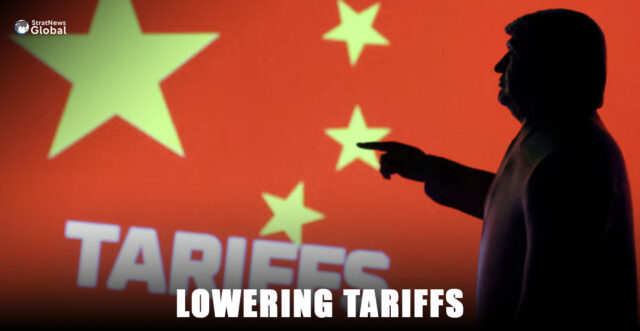On Friday, US President Donald Trump stated that an 80% tariff on China “seems right,” marking the first time he has proposed a specific alternative to the 145% tariffs already imposed on Chinese imports, just ahead of highly anticipated talks between the two nations this weekend.
US Treasury Secretary Scott Bessent and chief trade negotiator Jamieson Greer will meet Chinese economic tsar He Lifeng in Switzerland to discuss containing the damaging trade war between the world’s two biggest economies, which has already entangled global supply chains.
Asked how Trump arrived at the 80% figure, White House spokeswoman Karoline Leavitt said, “That was a number the president threw out there, and we’ll see what happens this weekend.”
Trump will not unilaterally bring down tariffs on China, however, she stressed.
“We need to see concessions from them as well,” she said.
Fentanyl
China is also sending a top public-security official to the talks in Geneva, a source familiar with the plans said. The development, first reported by the Wall Street Journal, underscores the importance of the issue of fentanyl trafficking to the talks and the wider US-China relationship.
Trump cited fentanyl as the rationale for the initial imposition of punitive import taxes on goods from China, Canada and Mexico earlier this year.
China’s embassy in Washington did not respond to a request for comment.
“China should open up its market to USA – would be so good for them!!! Closed markets don’t work anymore!!!” Trump wrote in an all-caps social media post. “80% tariff on China seems right. Up to Scott B.,” he added moments later.
President Trump said he expects meaningful trade talks with China this weekend and predicted a possible reduction in US tariffs.
Meanwhile, China criticized the US for using what it called aggressive and unsustainable trade tactics.
Trade expert Ryan Majerus noted that declining port and trade activity may be pressuring both sides to engage, though he warned that a simple resolution is unlikely — suggesting a limited deal with modest tariff reductions could be possible.
Asked by a reporter in the Oval Office on Friday whether he had given Bessent a number reflecting how low he was willing to go, Trump said yes, though he left it unclear whether his bottom-line figure was the same 80% he floated publicly.
Making A Great Deal For America
“We have to make a great deal for America,” he said. “I put out a number today, 80%, so we’ll see how that all works out.”
The weekend talks come on the heels of Trump’s first agreement with a major trading partner: Thursday’s announcement of a pact with Britain. While that fueled some optimism in markets, it was fairly limited in scope, and a range of details still need to be hammered out.
“The US-U.K. trade agreement may be better than nothing, but it is not significant enough to warrant a change to our forecast,” Nancy Vanden Houten, lead US economist at Oxford Economics, wrote on Friday. “While talks this weekend between US and Chinese officials may yield some progress, expectations for a significant reduction in tariffs seem unwarranted.”
Oxford estimates that lowering tariffs on China to 80% would bring the overall effective import tax rate from all the tariffs imposed by Trump so far to 18% from around 22% now. That would still be treble what Oxford had estimated at the start of Trump’s term and far above the 2-3% average from before he returned to office.
US Stocks Muted
While Trump has often said tariffs on China could come down, this is the first time he has suggested a specific alternative — an 80% rate, which, though lower than current levels, is still very high.
It’s unclear how China will respond, especially amid what some see as a de facto trade embargo.
Investors remain focused on where tariff rates will ultimately land, as market volatility has been driven by the uncertainty around Trump’s trade policies. US stocks ended the week slightly down, and the dollar weakened against major currencies.
Since taking office in January, Trump has hiked the tariffs paid by US importers for goods from China to 145%, in addition to those he imposed on many Chinese goods during his first term and the duties levied by the Biden administration.
China hit back by imposing export curbs on some rare earth elements, vital for US manufacturers of weapons and electronic consumer goods, and raising tariffs on US goods to 125%. It also imposed extra levies on some products including soybeans and liquefied natural gas.
Dwindling Approval Ratings
Trump’s tariff strategy is raising concerns about economic risks in the US, including higher consumer prices and potential weakening of job market support.
His approval ratings are slipping as Americans anticipate rising costs on everyday goods from China.
Meanwhile, China is working to cushion its manufacturers from US market losses.
Despite tensions, Swiss Vice President Guy Parmelin expressed optimism after bilateral meetings with both delegations in Geneva.
“It’s already a success,” Parmelin told reporters. “The two sides are talking … If a road map can emerge and they decide to continue discussions, that will lower the tensions.”
(With inputs from Reuters)





